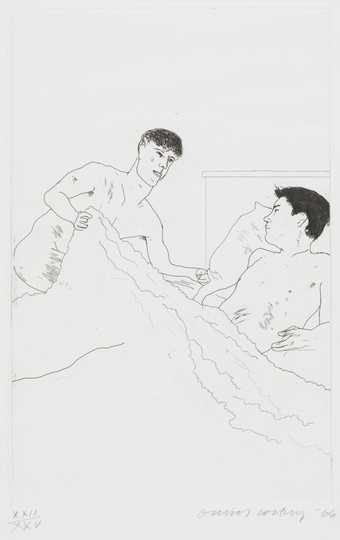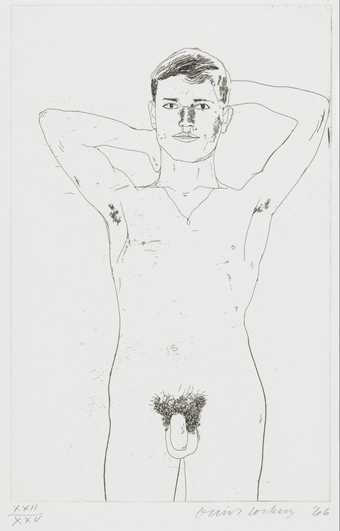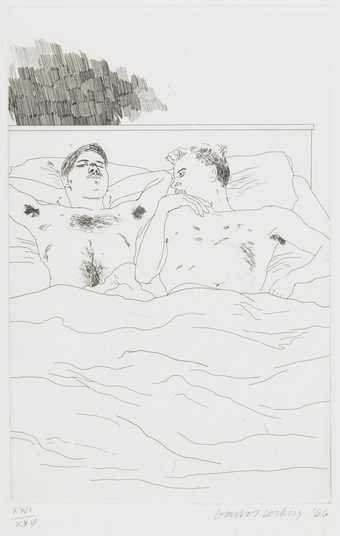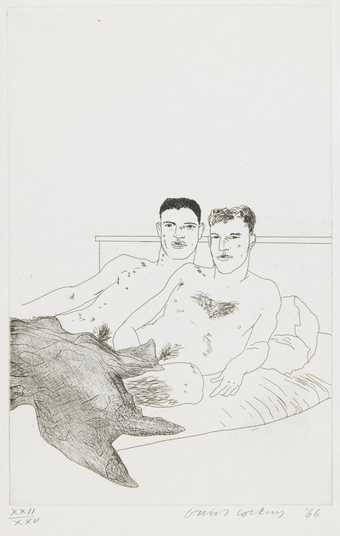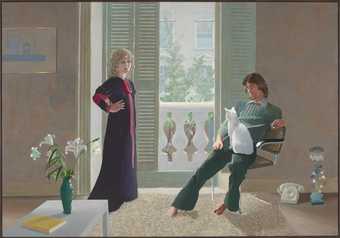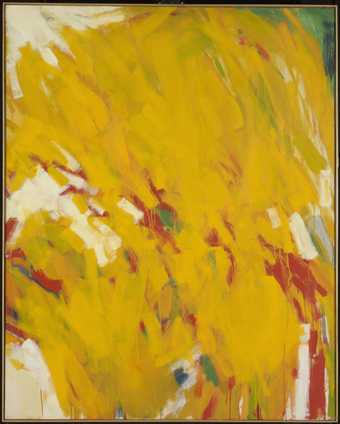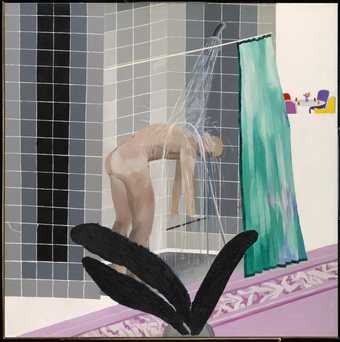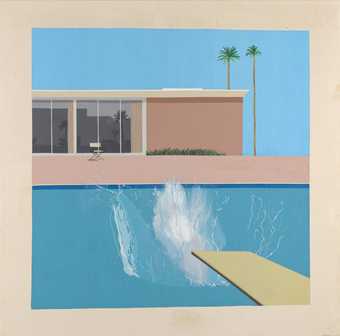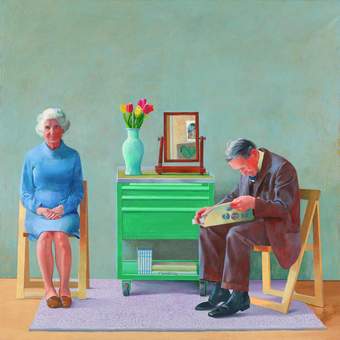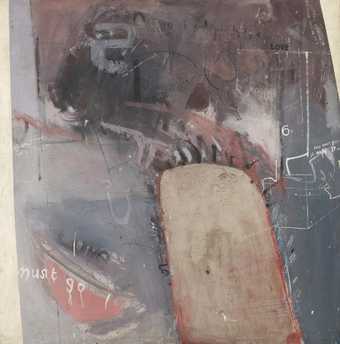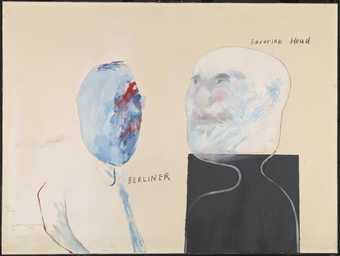
On loan
Museum of Contemporary Art Tokyo (Tokyo, Japan): David Hockney, in collaboration with the Hockney Studio
- Artist
- David Hockney born 1937
- Medium
- Oil paint on canvas
- Dimensions
- Support: 2325 × 830 × 38 mm
- Collection
- Tate
- Acquisition
- Purchased with assistance from the Art Fund 1996
- Reference
- T07075
Summary
This is one of the four Demonstrations of Versatility which Hockney exhibited at the Young Contemporaries student show in February 1962. The others were A Grand Procession of Dignitaries in the Semi-Egyptian Style, 1961 (private collection), Swiss Landscape in a Scenic Style, 1961 (retitled Flight into Italy - Swiss Landscape, Kunstmuseum, D-4sseldorf) and Figure in a Flat Style, 1961 (private collection). In a conversation with the American artist Larry Rivers, published in Art and Literature 5 (summer 1965), Hockney said of these works: 'I deliberately set out to prove I could do four entirely different sorts of picture like Picasso. They all had a sub-title and each was in a different style, Egyptian, illusionistic, flat - but looking at them later I realized the attitude is basically the same and you come to see yourself there a bit.' (reprinted in Livingstone, p.41.)
Also known as The Third Tea Painting, this is the last of a series of three paintings based on Typhoo Tea packets, made while Hockney was still a student at the Royal College of Art. The tea paintings marked a return to the depiction of recognisable images, after Hockney's early attempts at abstraction. In his studio at the College he was surrounded by tea packets:
I used to go into the Royal College of Art very early in the morning ... before Lyons had opened in South Kensington, and I used to make my own tea in there ... it was always Typhoo tea, my mother's favourite ... The tea packets piled up with the cans and tubes of paint ... and I just thought, in a way it's like still-life paintings for me ... There was a packet of Typhoo tea, a very ordinary popular brand of tea, so I used it as a motif. This is as close to pop art as I ever came.This painting shows a figure apparently seated within the confines of a narrow cubicle ( the Typhoo Tea box, complete with painted inscriptions including the misspelt 'TAE'. 'I am a bad speller, but to spell a three-letter word wrong!! But it's drawn in perspective and it was quite difficult to do. I took so long planning it that in my concern for flatness or abstraction I spelt it wrong.' (Stangos p.64.)
(Stangos, pp.63-4)
The picture employed a shaped canvas, the first work by a Royal College student in which the stretcher departed from the traditional rectangle. Hockney made the stretcher himself. His intention was that, if the blank canvas was already illusionistic, he 'could ignore the concept of illusionistic space and paint merrily in a flat style - people were always talking about flatness in painting in those days' (Stangos, p.64). He soon abandoned the device, although it was taken up by other artists, notably Allen Jones in his 1962 Bus paintings.
Further reading:
Nikos Stangos (ed.), David Hockney by David Hockney, London 1976, pp.20, 63-64, 66, reproduced p.35 in colourMarco Livingstone, David Hockney, revised edition, London 1987,
pp.41, 43-4, reproduced pl.36 in colour
Terry Riggs
November 1997
Does this text contain inaccurate information or language that you feel we should improve or change? We would like to hear from you.
Display caption
‘This is as close to Pop Art as I ever came,’ Hockney later said, ‘but I didn’t use it because I was interested in the design of the packet or anything, it was just that it was a very common design.’ Made while Hockney was still a student at the Royal College of Art, its very English subject might be seen as an ironic comment on the prevalent fascination with American imports. His specially constructed ‘illusionistic’ canvas was intended to allow him to ‘ignore the concept of illusionistic space and paint merrily in a flat style’.
Gallery label, September 2016
Does this text contain inaccurate information or language that you feel we should improve or change? We would like to hear from you.
Explore
- emotions, concepts and ideas(16,416)
-
- formal qualities(12,454)
-
- visual illusion(118)
- food and drink(980)
-
- drink, tea(38)
- box(186)
- actions: postures and motions(9,111)
-
- sitting(3,347)
- man(10,453)
- male(959)
You might like
-
David Hockney According to Prescriptions of Ancient Magicians
1966 -
David Hockney In an Old Book
1966 -
David Hockney In the Dull Village
1966 -
David Hockney The Beginning
1966 -
David Hockney In Despair
1966 -
David Hockney Mr and Mrs Clark and Percy
1970–1 -
Richard Smith Painting
1958 -
David Hockney Man in Shower in Beverly Hills
1964 -
David Hockney A Bigger Splash
1967 -
David Hockney My Parents
1977 -
David Hockney The Third Love Painting
1960 -
David Hockney Bob, London
1964 -
David Hockney Study for Doll Boy
1960 -
David Hockney The Berliner and the Bavarian
1962 -
David Hockney George Lawson and Wayne Sleep
1972–5

